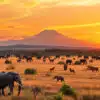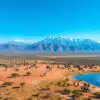Combining a Kenya Tanzania Safari



COMBINING A KENYA AND TANZANIA SAFARI
Kenya and Tanzania are located east of Africa and are one of the main safari destinations renowned for some of the best wildlife experiences. Combining a Kenya and Tanzania safari brings you close to an amazing array of Wildlife unmatched by any other destination. Kenya and Tanzania are host to one of the last and greatest animal migrations in the world where over a million ungulates move from region to another in search of greener and fresher pastures. With the amazing wildlife viewing opportunities, also come a few drawbacks that we will delve into to give you a better insight into the advantages and disadvantages of taking this dream Kenya and Tanzania Safari.

ADVANTAGES OF A KENYA TANZANIA SAFARI
Best and varied Wildlife safari Viewing opportunities
Combining a Tanzania and Kenya Safari has its advantages in Wildlife sightings. The combined safari gives you a guarantee to seeing and experiencing the Big Five animals. With the most difficult of the Big five being the Leopard and Rhino. The Rhinos are easily seen at some of the conservancies and national parks in Kenya with ease. Lake Nakuru, Ol Pejeta and Solio have quite some populations of the white and Black Rhino with easy sightings during game safaris. Masai Mara, Serengeti and Ngorongoro Crater are also host to the Black Rhino which is a more elusive species between both the Black and White Rhino. Some of the best areas to see the Leopard is the Samburu and Masai Mara in Kenya and Serengeti, Ruaha and Selous in Tanzania.

Guarantee into the Wildebeest and Zebra Migration Experience
The Wildebeest Migration centers around movement of the herds between Kenya and Tanzania. The Migration is present in Kenya between the months of July to October. The overall period and time they spend in Kenya is not pegged on any specific date range and therefore sometimes the migration can start early and end earlier or later with varied intensities. For the other months of the year, the Migration is in Tanzania. The herds move some approximately 160 kilometers south towards the Southern Serengeti and eastern towards the Ngorongoro Crater. The herds can be viewed around the Ngorongoro Conservation area during the months of December to March. Between March and June the herds are slowly migrating north towards Kenya. By combining Kenya and Tanzania for your safari, you will either experience the herds in Kenya, Serengeti or Ngorongoro Conservation area around the lake Ndutu region. You can select an accommodation option that is closest to the herds in any of the main concentration areas of the migration corridor being the Northern Serengeti, Central Serengeti, Southern Serengeti or Lake Ndutu in the Ngorongoro Conservation area.
Different Landscape Experience
The Landscape varies from one park or game reserve to the other. Kenya has a more varied option of landscape as compared to the Northern Tanzania. Samburu in the north is more arid scrub land while the Masai Mara in Kenya is more savanna’s dotted with riverine forest and acacias spotting the landscape. Amboseli further south in Kenya is open Savannah with the backdrop of the Kilimanjaro, Africa’s tallest mountain. The Aberdare is part of a mountainous range with dense forest and waterfalls.
In Tanzania, the northern Tanzania has the Tarangire, Ngorongoro and Serengeti. The Serengeti shares an ecosystem with the Masai Mara and also is similar in altitude and landscape. The Ngorongoro crater is a collapsed caldera with quite an amazing density of wildlife. The drive into the crater is also part of the adventure as the Jeeps slowly crawl down the steep slopes into the caldera. The Ngorongoro Crater viewed from the lodges/Camps on the crater rim is an amazing sight during the sunrise and sunset hours.
The Tarangire is more arid and low with a huge density of Elephants and the Baobab trees. In Kenya the Baobabs can be found south of Kenya in the Tsavo West National park. The Tsavo East and West in Kenya are also host to huge density of Elephants

Cost of Flying to East Africa
Flying to Africa can be quite expensive. Flying from Europe to Africa is cheaper than flying from the South America, America and Australia which can set you off quite a few thousands in dollars. For this reason if you are looking at traveling to Africa as a bucket list travel plan, then taking a return flight to either Nairobi or Kilimanjaro and taking a safari to both Tanzania and Kenya would be cost effective rather than taking two different flights and two different safaris. You could easily fly to Jomo Kenyatta International Airport in Nairobi, Kenya and start your safari in Kenya crossing to Tanzania and ending the safari in Nairobi in time for your flight back home. This would also mean you have saved up on time planning for the trip in two different countries one off. The drive from Kenya to Tanzania is seamless and you can cross the border at either Namanga if coming from Amboseli or Arusha or cross the border at Isebania if driving from the Mara to Serengeti or vice versa.

THE DISADVANTAGES OF A KENYA TANZANIA SAFARI
More Number of Days on Safari needed
The safari to both combine Kenya and Tanzania has its down sides to it. This would mean you are visiting more parks and therefore there is a minimum number of days you would require to realize the safari comfortably. We would advise planning for a minimum of eight days but you can also make it longer to enjoy the safari at a relaxed pace and also include more and diverse national parks offering different varied experiences. Ideally spending more days in the larger parks will also give you ample time to explore these vast areas and more successful wildlife viewing experiences. This is also advisable during the wildebeest Calving season at Ngorongoro Conservation area bordering the Serengeti. Spending at least two days at the Lake Ndutu area and another 3 days at Serengeti would be ideal since these are two different national parks.
High Cost of the Safari
One of the major downside to combining the Kenya Tanzania safari is the overall cost towards the safari. This is majorly influenced by the use of two different transport vehicles for the safari. In Kenya, only registered Kenya safari vehicle can access the national parks and reserves and in Tanzania, only Tanzania registered vehicles can access the parks. This involves extra transport costs and guide costs during the cross border transfers between Kenya and Tanzania. If crossing from Isebania for instance which is the western border crossing closest to Masai Mara, a safari vehicle has to depart from Arusha a day before and drive to the Isebania while the safari vehicle form Masai Mara dropping you at the border will need an extra day for the drive back to Nairobi. This extra transport logistics will occasion an increase in the overall cost of the safari when combining the Kenya and Tanzania safari.

Longer Distance Traveling Hours between the cross border parks
The cross border transfers from Amboseli to either Tarangire, lake Manyara can be long and tedious sometimes. The average border crossings take about an hour to get immigration and clearance at the border. This coupled with the drive from the border makes up an average of 6 hours on non-game viewing drive time. The drive also from Masai Mara to Serengeti takes up about 6 hours for the drives between Serengeti in Tanzania and Masai Mara. This gives the general feel of a day lost. There is the possibility of flying between the Serengeti and Masai Mara at a cost and this saves up on vital time that would be used for game viewing. It’s advisable to go for a safari package that has a minimum of 03 nights in Serengeti and Masai Mara to recover on the extra day lost or plan to have a stop at the shore of lake Victoria Speke’s bay.
For more information regarding planning and organizing for a Kenya Tanzania Safari Combined, please do not hesitate to contact us for advise or any assistance OR curate your Safari with Us.


